Why Every Parent Wants the Best for Their Kids
You know that feeling when you walk into your child’s room and can barely see the floor? Yeah, I’ve been there too. We all want to give our kids the world, right? But sometimes giving them everything turns into a chaotic mess that makes us wonder if we’ve actually done them any favors.
I remember the first time I realized my daughter’s bedroom had become more obstacle course than peaceful retreat. There were toys everywhere, clothes spilling out of drawers, and don’t even get me started on trying to find that one specific stuffed animal at bedtime. It hit me then that wanting the best for our kids means more than just buying them stuff. It means creating spaces where they can actually enjoy being kids without tripping over everything they own.
We spend so much time thinking about what to put into our children’s rooms. New toys for birthdays, that cool lamp shaped like a rocket ship, another bookshelf for the growing library of picture books. But here’s the thing we don’t think about enough: how all that stuff fits together. Or more accurately, how it doesn’t fit together. When I started paying attention to how my kids actually used their space, I noticed they weren’t playing with half their toys simply because they couldn’t reach them or didn’t remember they existed under the mountain of other things.
Think about your own bedroom for a second. You probably like it calm, organized, and set up in a way that makes sense for how you live. You can find your clothes in the morning without a treasure hunt. Your bed is comfortable and inviting at the end of a long day. Now think about what we often give our kids. Cramped spaces stuffed with furniture that’s too big, storage that doesn’t work, and a general sense of chaos that would stress out any adult within minutes.
Our kids deserve better than that. They deserve rooms that work for them, not against them. And here’s something that took me way too long to figure out: a room that works well doesn’t have to cost a fortune or look like something out of a magazine. It just needs to make sense for the tiny human who lives there.
When my son was three, he went through this phase where he refused to play in his room. He’d drag every single toy into the living room, leaving a trail of destruction in his wake. I couldn’t understand it at first. He had a perfectly good room with plenty of toys. Why wouldn’t he play there? Then one afternoon I actually sat on his floor and looked around from his height. The room felt crowded. The furniture was dark and heavy. He couldn’t reach most of his toys without help. No wonder he didn’t want to hang out there.
That’s when I started rethinking everything. We don’t need to give our kids more stuff. We need to give them space that actually functions for their needs. Space where they can play freely, find their favorite things easily, and yeah, maybe even clean up without it feeling like an impossible task. Because let’s be honest, getting kids to clean their rooms is hard enough without the furniture working against you.
The toy situation in most kids’ rooms is just one piece of the puzzle. What about when bedtime rolls around and you realize you have nowhere to actually sit and read a story? Or when they want to have a friend over for a sleepover but there’s literally no floor space for a sleeping bag? These aren’t small problems. These are daily frustrations that make parenting harder than it needs to be.
I’ve learned that keeping our kids cheerful and entertained isn’t about having the most toys or the fanciest furniture. It’s about creating an environment where they can be themselves. Where they can spread out a puzzle without knocking over a tower of storage bins. Where they can dance around without bumping into furniture corners. Where they can actually enjoy being in their own space.
And here’s something nobody told me before I became a parent: kids pick up on stress. When we’re frustrated with the mess, they feel it. When we’re constantly nagging them to clean up an impossibly disorganized room, they internalize that. Creating a functional, pleasant space for them isn’t just about the physical room. It’s about reducing everyone’s stress levels and making home feel like, well, home.
The bedroom furniture we choose plays a huge role in all of this. I used to think furniture was just furniture. You need a bed, a dresser, maybe a desk. Check those boxes and you’re done, right? Wrong. The size, style, and functionality of each piece can either create harmony or complete chaos in a small space. And most kids’ rooms are small spaces. We’re not usually giving them the master suite with the walk in closet and attached bathroom.
So when we talk about giving our kids everything within reach, maybe we should start thinking differently about what that means. It’s not about quantity. It’s about quality of life in their personal space. It’s about setting them up for success, whether that’s playing independently, sleeping peacefully, or yes, even cleaning up after themselves without a complete meltdown.
I wish someone had told me all this before I bought my first set of kids’ bedroom furniture. I went for what looked cute in the store without thinking about whether it would actually work in the small bedroom we had available. That dresser that seemed so perfect? Way too deep for the room. It stuck out and created a weird bottleneck that made the whole space feel cramped. Live and learn, I guess.
The good news is that once you understand what actually matters in a kids’ room, fixing the problems isn’t as hard as you might think. You don’t need to throw everything out and start over with an unlimited budget. You just need to think more strategically about the furniture you choose and how it serves your child’s daily life. And that’s exactly what we’re going to talk about in the rest of this guide.

How Kids Really Use Their Bedrooms
Let’s talk about what actually happens in a kid’s bedroom, not what we imagine happens or what we wish would happen. Kids don’t treat their rooms like adults treat theirs. We adults use our bedrooms mainly for sleeping, getting dressed, and maybe reading before bed if we’re not too exhausted. Kids? They’re running an entire entertainment complex in there.
I’ve watched my kids in their rooms when they don’t know I’m peeking in. They’re not just playing quietly with one toy at a time like some kind of 1950s television commercial. They’re building forts with every blanket and pillow in the house. They’re turning the floor into lava and leaping from the bed to the dresser to that chair we probably shouldn’t have put so close to the bed. They’re spinning in circles until they’re dizzy and then flopping down to stare at the ceiling and giggle.
Your kid’s bedroom is their gym, their art studio, their laboratory, their stage, and their hiding spot all rolled into one. They jump on the bed even though we tell them not to. They roll across the floor practicing their ninja moves. They sit in corners having deep conversations with their stuffed animals. They race toy cars across every available surface. They create elaborate games that require spreading toys from one end of the room to the other.
This is all normal kid behavior. This is what childhood looks like. And yet, we often set up their rooms like we’re designing a miniature adult bedroom. We fill the space with furniture that assumes they’ll use the room the way we use ours. Then we get frustrated when reality doesn’t match our expectations.
Here’s a story that might sound familiar. Last summer, my neighbor bought her son this gorgeous bedroom set she found on sale. It was real wood, beautifully crafted, and looked like something from a fancy furniture showroom. The bed frame sat high off the ground with thick posts at each corner. The dresser was this massive piece with ornate drawer pulls. The nightstand matched perfectly. She was so proud of it.
Three weeks later, she was complaining to me over coffee about how her son never wanted to be in his room anymore. The kid was eight years old and suddenly spending all his time in the playroom downstairs or outside. When she asked him why, he said his room felt “weird.” She couldn’t figure it out until one day she tried to help him make his bed and realized how awkward it was. The bed was so high and bulky that she could barely reach across to tuck in the far side. For her eight year old? Forget it.
The dresser drawers were so heavy that he needed help opening them. The nightstand, while pretty, had sharp corners at exactly the wrong height. The whole room felt like a furniture showroom instead of a kid’s space. She’d spent a fortune creating a room that didn’t work for the person who had to live there. That’s when she started researching bedroom furniture designed with actual kids in mind.
Most kids’ bedrooms are smaller than adult bedrooms. That’s just how houses are built. The master bedroom gets the most space, and kids’ rooms are usually secondary bedrooms that might measure ten by twelve feet or even smaller. Now imagine trying to fit a full size bed, a bulky dresser, a desk, a bookshelf, and toy storage into a space that size. Then imagine trying to leave enough floor space for a kid to actually play. The math doesn’t work.
But we keep trying to make it work by cramming in full sized furniture. We pick dressers that belong in a master bedroom. We choose bed frames that eat up half the room. We add nightstands on both sides like we’re setting up a hotel room. Then we wonder why the room feels so cramped and why our kids don’t enjoy spending time there.
I made this exact mistake with my first child. I bought what I thought was a “kids” bedroom set from a big box store. The sales person assured me it was perfect for children. Looking back, I realize it was just regular bedroom furniture painted in bright colors. The scale was all wrong. The dresser was so deep that it stuck out into the room and created this awkward traffic pattern. My daughter couldn’t reach the top drawers. The bed frame had these decorative finials that she bumped her head on approximately five hundred times.
We lived with that furniture for three years before I finally admitted defeat and started over. Those three years, her room was always a mess. She couldn’t put away her own clothes because the drawers were too hard to open and she couldn’t reach half of them anyway. She couldn’t make her own bed because the frame made it too complicated. The room always felt chaotic and cramped, which meant she avoided being in there unless she was sleeping.
Kids need room to move. They need floor space for playing. They need furniture that’s actually scaled for their size and strength. When my daughter finally got a room set up properly, the difference was night and day. Suddenly she wanted to play in her room. She could put away her own things. She invited friends over and they actually had space to play together. The room went from being a source of stress to being her favorite spot in the house.
The worst part about oversized furniture in a kid’s room isn’t just the cramped feeling. It’s the way it limits what they can do independently. When they can’t reach their clothes, they can’t get dressed by themselves. When they can’t access their toys easily, they can’t clean up by themselves. When the space is so packed with furniture that there’s no floor space, they can’t play by themselves. We accidentally create dependence when we’re trying to create a nice room for them.
And let’s talk about safety for a second. Kids climb on things. All kids, even the ones who seem calm and well behaved. They climb because they’re curious and because climbing is fun and because that’s what kids do. When you have oversized, heavy furniture in a small space, you’re creating climbing temptations that are genuinely dangerous. That tall dresser? Perfect for climbing to a kid. That bed frame with the high posts? Great hand holds. We’re not thinking about these things when we’re shopping, but we should be.
I’ve been in kids’ rooms where the furniture takes up so much space that you literally have to turn sideways to walk between pieces. Where the bed is pushed up against one wall and the dresser is against the other, leaving a narrow hallway between them. Where closets can’t be fully opened because furniture is blocking them. Where windows are covered by furniture because there’s simply nowhere else to put it. This isn’t creating a pleasant space for anyone.
The irony is that parents usually choose this oversized furniture with good intentions. We think bigger means better. We think investing in “real” furniture means buying adult sized pieces. We think our kids will grow into it. But kids don’t experience time the way we do. Three years until they grow into that furniture feels like forever to them. And in the meantime, they’re stuck with a room that doesn’t work.
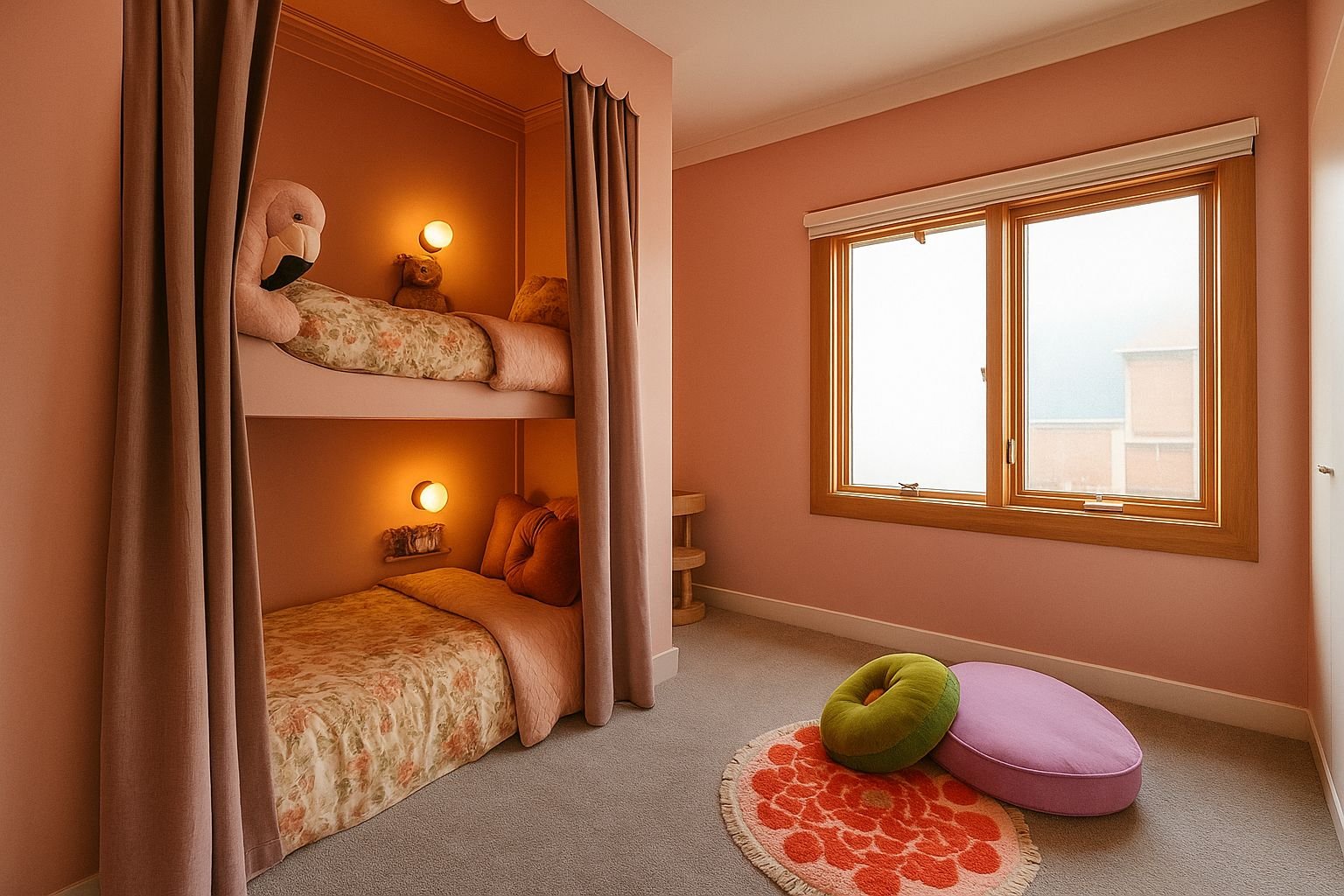
Choosing Furniture That Actually Makes Sense
So if cramming our kids’ rooms full of oversized furniture is the problem, what’s the solution? It starts with changing how we think about bedroom furniture in the first place. We need to stop asking “What looks nice?” and start asking “What actually works for my child’s daily life?”
I learned this lesson the hard way, but you don’t have to. When my second kid was ready to move out of the nursery and into a big kid room, I did things completely differently. Instead of shopping first, I sat down and really thought about how he used his space. What did he do every day? What drove both of us crazy about the current setup? What would make his life easier and our lives less stressful?
Here’s what I figured out. Every morning, he needed to get dressed. That meant he needed access to his clothes without my help. Every night, we read stories before bed. That meant we needed space for books and a comfortable spot to sit together. Multiple times a day, he played with toys that needed somewhere to go when playtime was over. That meant we needed storage that made sense. And throughout all of this, he needed floor space to actually be a kid.
Once I had that list, furniture shopping became so much easier. I wasn’t looking at what was pretty or what was on sale. I was looking at what would solve our actual daily problems. And you know what? The furniture that solved those problems looked different than what I’d bought the first time around.
The bed didn’t need to be a statement piece. It needed to be the right size for the room and easy for him to make by himself. The dresser didn’t need to match some design aesthetic. It needed drawers he could actually open and close. The storage didn’t need to be hidden away in expensive built ins. It needed to be accessible so he could clean up independently.
This is where a lot of parents get tripped up. We walk into furniture stores or start scrolling through websites, and we get distracted by how things look. That bedroom set is so cute with the racing car theme! This dresser has such beautiful hardware! Look at this canopy bed, wouldn’t it be magical? But we’re not the ones who have to live with these choices day in and day out. Our kids are.
I’m not saying bedroom furniture can’t be attractive. Of course we want our kids’ rooms to look nice. But function has to come first. A gorgeous dresser that your seven year old can’t use without help isn’t doing anyone any favors. A bed frame that looks amazing but creates a cramped room isn’t worth the Instagram photo.
Let’s talk about scale for a minute. Kids are smaller than adults. I know this seems obvious, but we forget it when we’re shopping for furniture. A drawer that opens easily for you might be nearly impossible for your six year old. A bed that seems low to the ground for you might feel high to your preschooler. Closet rods at standard height are completely out of reach for most kids under ten.
When you’re evaluating furniture for a child’s room, you need to think about it from their physical perspective. Can they reach what they need to reach? Can they open and close drawers without a struggle? Can they climb into bed safely? Can they see themselves in the mirror you’re planning to hang? These questions matter more than matching wood finishes or finding the perfect shade of blue.
Storage is probably the biggest challenge in any kid’s room. They have so much stuff. Clothes, toys, books, art supplies, random treasures they’ve collected, stuffed animals, puzzles, games, and on and on. Where does it all go? If you choose furniture with inadequate storage, you’ll end up with piles of stuff everywhere. But if you choose furniture with storage that doesn’t make sense, you’ll still end up with piles of stuff everywhere.
The key is thinking about how kids actually put things away. Spoiler alert: they don’t carefully fold clothes and place them in drawers by category. They don’t organize their toys by type. They don’t alphabetize their books. Kids need storage solutions that match their actual behavior, not our ideal vision of how they should behave.
That’s why furniture with lots of small, fussy drawers usually doesn’t work well in kids’ rooms. It’s too complicated. But furniture with big, open storage areas? That works great. Kids can toss things in bins, shove clothes in drawers, and stack books on shelves without needing a degree in organization. We’re not trying to create perfect order. We’re trying to create functional order that a child can maintain.
I used to fight with my kids about putting toys away properly. I had this elaborate organizational system with labeled bins for different types of toys. Cars went in one bin, blocks in another, dolls in a third, and so on. It looked great when I set it up. It lasted approximately two days before complete chaos reigned again. My kids couldn’t maintain that system because it was too complicated for them. When I simplified to just a few large toy boxes where anything could go, cleanup became actually doable.
The same principle applies to bedroom furniture. Simple is better. Functional is better. Appropriate for your child’s age and abilities is better. That might mean choosing a dresser with fewer but larger drawers. It might mean skipping the nightstands entirely to create more floor space. It might mean choosing a bed with built in storage instead of a traditional frame plus separate storage pieces.
Room size matters a lot too. Before you buy any furniture, measure the room. Not just roughly, but actually measure it. Then measure the furniture you’re considering. Map it out on paper or use one of those room planning apps. See how much floor space you’re left with after placing the furniture. If the answer is “not much,” you need smaller pieces or fewer pieces.
I’ve seen too many kids’ rooms where the furniture takes up 75% of the space and there’s just a narrow strip of floor left for playing. That’s backwards. In a child’s room, the open floor space should be the priority. The furniture should fit around the edges, leaving the center open for all those activities we talked about earlier. Rolling around, building forts, racing cars, dancing, all of it.
One thing that helped me make better furniture decisions was thinking about flexibility. Kids grow and change fast. Their needs at five are different from their needs at eight or twelve. Furniture that can adapt as they grow is worth its weight in gold. That might mean choosing pieces that can be reconfigured, or it might mean choosing simple, timeless pieces that work across different ages.
I also learned to think about the whole room as a system rather than individual furniture pieces. How does the bed relate to the dresser? Where do toy storage and book storage fit? Is there space to move between furniture pieces? Can you open drawers and doors without bumping into other furniture? These questions about how pieces work together are just as important as the qualities of individual items.
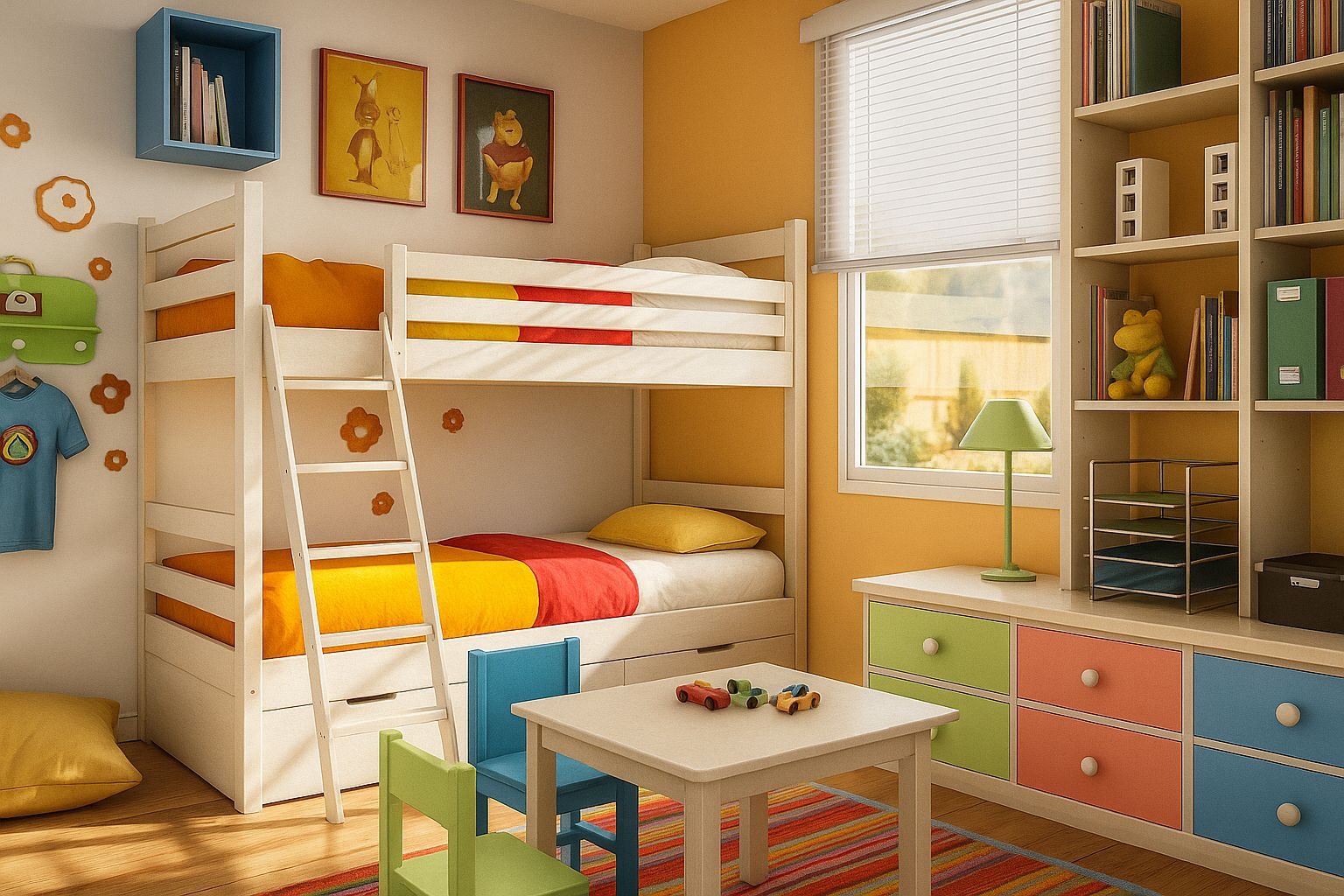
Why Bunk Beds Might Be Your New Best Friend
Okay, let’s talk about bunk beds. I know what you’re thinking. Bunk beds are what you buy when you have multiple kids and not enough bedrooms, right? Or maybe you’re picturing those metal frame monstrosities from summer camp that squeaked every time someone moved. But hear me out, modern bunk beds designed for kids’ bedrooms are game changers, even if you only have one child.
I was skeptical too at first. When someone suggested a bunk bed for my daughter’s room, I laughed. She didn’t have a sibling sharing her room. Why would she need a bunk bed? Then they explained it wasn’t just about sleeping. It was about making the most of vertical space so we could actually have floor space for playing. That’s when I started paying attention.
Think about how a traditional bed uses space. It sits on the floor, taking up maybe 40 square feet of your room. That’s 40 square feet your kid can’t use for anything else. Now think about a bunk bed. It still only takes up about 40 square feet of floor space, but you’ve got options. You can sleep on top and use the space underneath for storage, a study area, or even a cozy reading nook. You’ve essentially doubled the functionality of that footprint.
The bunk beds made for kids today aren’t like the ones we remember. They’re designed with actual thought put into what kids need. Many of them aren’t even traditional two tier sleeping bunks. Some have a bed on top and a whole workspace underneath with a desk and shelves. Some have a bed on top and a dresser, closet, and storage cubbies underneath. Some have twin beds stacked with storage drawers built into the stairs.
When we finally got a loft bed for my daughter’s room, it was like we’d added 30 square feet to the space. We hadn’t actually made the room bigger, we’d just used the space smarter. Suddenly she had floor space to spread out her art projects. She could have friends over and they had room to play. The room went from feeling cramped and claustrophobic to feeling open and fun.
The storage aspect of modern bunk beds and loft beds can’t be overstated. Remember how I said kids have tons of stuff? Well, that stuff needs somewhere to go. Instead of buying a bed, plus a dresser, plus a bookshelf, plus toy storage, you can get a bunk bed system that incorporates all of that. Some of these units have drawers built into the frame. Some have shelves and cubbies as part of the structure. Some even have hanging space for clothes.
This integrated approach to storage makes so much more sense than scattered furniture pieces. Everything has its place, and that place is part of one cohesive unit. It’s easier for kids to remember where things go when it’s all connected. Plus, having storage as part of the bed structure means you’re not sacrificing floor space for dressers and shelves.
Now, I know some parents worry about safety with bunk beds. That’s fair. You’re putting your kid up higher off the ground, and falls can happen. But here’s the thing. Modern bunk beds designed for home use have come a long way in terms of safety features. Sturdy guardrails, stable ladders, and solid construction are standard. And kids are generally pretty good at navigating their own furniture once they get used to it.
My daughter was five when we got her loft bed. I was nervous at first. Would she fall trying to climb up? Would she roll off in her sleep? None of that happened. We talked about safety rules. She practiced climbing up and down while I spotted her. Within a week, she was scrambling up and down like she’d been doing it her whole life. Kids are more capable than we give them credit for.
The fun factor of bunk beds shouldn’t be ignored either. Kids think they’re cool. Sleeping up high feels like an adventure. The space underneath becomes a fort or a secret hideout. Some bunk beds come with slides. Can you imagine how much more excited your kid would be about bedtime if they got to climb up a ladder and sleep in what feels like a treehouse?
We’re always looking for ways to make parenting easier, right? Making bedtime more appealing is a win. If a cool bed helps with that, I’m all for it. My daughter used to resist going to her room at bedtime. After we got the loft bed, she couldn’t wait to climb up there with her stuffed animals and books. It became her special space that she actually enjoyed being in.
Bunk beds also grow with your kids better than traditional beds. A toddler bed becomes obsolete when your kid gets bigger. A twin bed might work for years, but it’s just a bed. A bunk bed with built in storage and workspace can evolve with your child from early elementary through the teenage years. You might reconfigure how the space underneath is used, but the basic structure works across ages.
The customization options with modern bunk beds are pretty impressive. You can find them in every style from sleek and modern to rustic wood to bright and colorful. Many companies let you choose configurations based on your needs. Want more drawer space? Done. Need a bigger desk area? They’ve got that. Prefer open shelving to closed cabinets? Not a problem.
And here’s something I didn’t expect. Having a bunk bed or loft bed actually made my daughter more independent. The storage was accessible to her. The desk underneath was her space to do homework or draw. Everything she needed was right there in her little zone. She stopped needing me to help her find things or get things down from high shelves. The furniture worked for her, not against her.
Bunk beds aren’t just for small rooms either, though they definitely shine in tight spaces. Even in a decent sized bedroom, using vertical space creates opportunities you wouldn’t have otherwise. My friend’s son has a bigger bedroom, and they still chose a bunk bed system. The bottom bunk is for sleeping, and the top bunk is basically a reading loft with pillows and blankets. He loves having two distinct spaces in his room.
If you’re worried about the initial cost, think about what you’re getting. Instead of buying a bed, dresser, desk, and storage units separately, you’re getting it all in one system. When you add up what you’d spend on individual pieces, a quality bunk bed often costs about the same or even less. Plus, you’re saving on the space those individual pieces would take up.
The climbing aspect of bunk beds is actually good for kids. They’re developing coordination and strength every time they go up and down that ladder. It’s movement built into their daily routine, which is great since kids need way more physical activity than most of them get these days. Every trip up to bed or down to grab something is a little bit of exercise.
I’ve talked to a lot of parents who regret not getting a bunk bed sooner. They spent years struggling with cramped rooms and inadequate storage before finally making the switch. Every single one of them wished they’d done it earlier. The difference it makes in how functional and enjoyable the room becomes is that significant.
All the Cool Things About Modern Bunk Bed Designs
Let’s dive deeper into what makes modern bunk beds so much better than what you might remember from childhood. We’re not talking about those metal frame beds that felt like you were sleeping in a prison cell. We’re talking about thoughtfully designed furniture that solves real problems while looking good doing it.
Double deck bunk beds are the classic style most people picture. Two sleeping surfaces stacked on top of each other, connected by a ladder. But even this traditional style has evolved. Modern versions have better proportioned ladders that are actually comfortable to climb. The top bunk has higher, safer railings. The bottom bunk has more headroom so your kid doesn’t feel like they’re in a cave. Some designs have the top bunk offset slightly from the bottom to create more space and light for the lower sleeping area.
These double decks work great when you have two kids sharing a room, obviously. But they’re also popular with families who want to accommodate sleepovers without air mattresses taking over the living room. Your kid’s friend can crash on the other bunk, and everyone’s happy. During the week when there’s no sleepover, the extra bunk becomes storage for stuffed animals, a place to spread out craft projects, or whatever else your kid dreams up.
Twin over full bunk beds give you even more flexibility. The top bunk is a twin size, but the bottom bunk is a full size mattress. This creates a cozy reading nook or play space on that larger bottom mattress during the day, and comfortable sleeping for two kids during sleepovers. Some parents use the full size bottom bunk when kids are young so they can cuddle up together for bedtime stories.
The loft bed style is where things get really interesting for single kid rooms. Instead of two sleeping surfaces, you have one bed raised up high with completely open space underneath. What you do with that space is limited only by imagination. The most common setup is creating a workspace underneath with a desk and chair. I’ve seen these setups that look like legit little offices, complete with bulletin boards, desk lamps, and organized supply storage.
Other families use the space under a loft bed for a cozy hangout area. Throw some bean bags or floor cushions under there, add some string lights, and you’ve got a reading nook or a spot for quiet play. It becomes a little cave that kids love hiding away in. Some parents have even set up small TV and gaming areas under loft beds, creating an entertainment zone that keeps the mess contained.
Storage under loft beds can be incredibly efficient. You can fit a whole dresser under there, plus shelving units, plus toy storage bins. I’ve seen loft bed setups that incorporate more storage than you’d get from three or four separate furniture pieces. Built in cubbies, hanging rods for clothes, drawer units on wheels that slide in and out, shoe racks, book shelves. It’s all there, all accessible, and all in the footprint of a single bed.
The stairs versus ladder debate is real with bunk beds. Traditional bunk beds have ladders, which are fine but can be tough for younger kids or kids who wake up groggy in the middle of the night. Bunk beds with stairs instead of ladders are safer and easier to navigate. Plus, those stairs often have built in storage. Each step might be a drawer where you can stash socks, underwear, or small toys. You’re turning the access point into functional storage, which is brilliant design.
Some bunk beds come with slides. Yes, slides. Your kid climbs a ladder to bed at night and slides down in the morning. Is it necessary? Absolutely not. Is it awesome? Absolutely yes. I know a family whose morning routine improved dramatically when they got a bunk bed with a slide. Their son used to drag his feet getting out of bed every morning. After they got the slide bed, he couldn’t wait to wake up and slide down. Sometimes fun is a legitimate solution to parenting challenges.
The variety of themes and designs available today is wild. You can get bunk beds styled like castles, fire trucks, tree houses, spaceships, cottages, you name it. These themed beds turn sleeping quarters into play spaces. Kids role play around them, incorporate them into games, and genuinely love being in their rooms. The furniture becomes part of their imaginative play instead of just a place to sleep.
But themed beds aren’t for everyone, and that’s fine. You can also find incredibly sleek, modern bunk beds with clean lines and neutral colors that will work with any decor as your child grows. These timeless designs mean you’re not stuck with a princess castle when your daughter decides she’s into science and soccer. Good design doesn’t have to be babyish or theme dependent.
L shaped bunk beds are another creative solution. Instead of stacking beds directly on top of each other, they’re arranged in an L shape. This creates more headroom for both sleeping surfaces and often leaves floor space in the room’s layout where a traditional bunk wouldn’t. The perpendicular arrangement can actually work better in some room shapes.
Some bunk beds are designed to be separated later. When your kids are young and sharing a room, you have the bunk setup. As they get older and maybe get their own rooms, you can split the bunk into two separate beds. This flexibility means you’re not replacing furniture as your family’s needs change. You’re just reconfiguring what you already have.
The quality of materials in bunk beds today is generally much better than older models. Solid wood construction is common, giving you sturdy, long lasting furniture instead of flimsy metal frames or particle board that falls apart. These are pieces built to handle the climbing, playing, and general roughhousing that comes with having kids. They’re investments that last years, not months.
Customization is huge in the bunk bed market now. Some companies let you choose the color, the configuration, the storage options, and even the type of ladder or stairs. You’re basically designing a furniture system tailored to your specific space and needs. This level of customization used to be only available with expensive built ins, but now it’s accessible through modular bunk bed systems.
Safety standards for bunk beds have gotten much stricter over the years. Guardrails must meet certain height requirements. Slats supporting the mattress must be spaced properly. The structure must support specific weight loads. When you buy from reputable manufacturers, you can trust that the bed meets current safety codes. That peace of mind is worth a lot when you’re literally putting your kid to sleep several feet off the ground.
The fact that bunk beds make such efficient use of space means you can often fit other furniture in the room that you couldn’t otherwise. With the bed and storage taken care of vertically, you have floor space for things like a play kitchen, a craft table, or a dress up area. The room becomes more than just a bedroom. It becomes a true multipurpose space for your child.
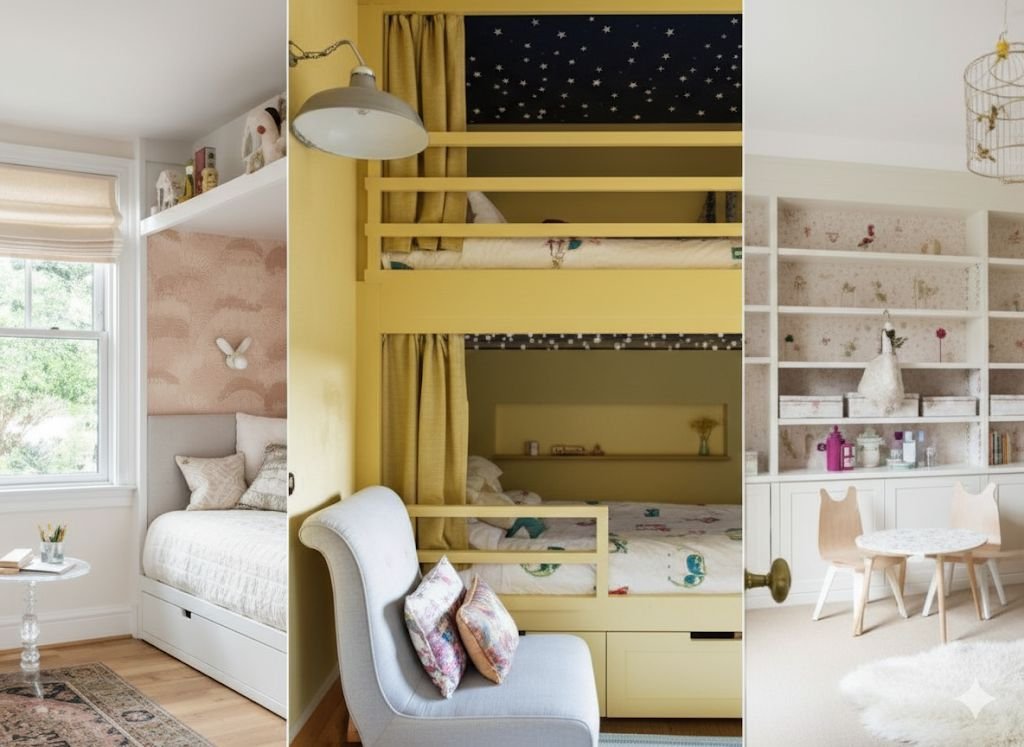
Trundle Beds Are the Secret Weapon You Didn’t Know You Needed
Right about now you might be thinking, okay, bunk beds sound great, but they’re not for everyone. Maybe your ceilings are too low. Maybe your kid is too young. Maybe you’re just not comfortable with the height thing. I get it. That’s where trundle beds come into the conversation, and trust me, they’re worth talking about.
A trundle bed is sneaky genius. It looks like a regular bed sitting in your room. But underneath the main bed, there’s another mattress on a rolling frame that pulls out when you need it. During the day, it’s tucked away out of sight. At night, or whenever you need extra sleeping space, you roll it out. When you’re done, it rolls back under. Simple, elegant, and so practical.
The space saving aspect of trundle beds is obvious. You get two sleeping surfaces in the footprint of one bed. For families with kids who love sleepovers, this is gold. No more dragging out air mattresses that go flat by morning. No more kids sleeping in sleeping bags on the hard floor. You pull out the trundle and boom, instant second bed.
But trundle beds aren’t just about sleepovers. Some families use them when siblings share a room but the room isn’t quite big enough for two separate beds or a bunk bed. During the day, the trundle stays tucked away and the kids have maximum floor space for playing. At night, both kids have their own comfortable sleeping surface. You get the functionality of two beds with the space requirement of one.
I know a single mom who got a trundle bed for her daughter’s room specifically for nights when her daughter needed extra comfort. If the daughter had a bad dream or wasn’t feeling well, mom could pull out the trundle and sleep right there without cramming into a twin bed or sleeping on the floor. Both of them could rest comfortably, and during normal nights, the room stayed open and spacious.
The storage possibilities with trundle beds are another big win. Not all trundles are mattresses. Some trundle bed systems give you the option of storage drawers instead of a second mattress. You pull out these large, flat drawers and store out of season clothes, extra blankets, toys that aren’t in regular rotation, board games, whatever you need to tuck away but keep accessible. It’s dead space under the bed put to good use.
Some trundle beds take the storage concept even further. The main bed might have drawers built into one side, the trundle mattress on the other side, and shelving in the headboard. You’re looking at a complete storage system that happens to also be a bed. Or two beds. The efficiency is beautiful when you’re dealing with limited square footage.
Trundle beds work particularly well in rooms with lower ceilings where bunk beds might feel cramped. You get similar space saving benefits without the vertical element. This makes them great for older houses with shorter ceilings, or for basement bedrooms, or for parents who just aren’t comfortable with the height of bunks.
The ease of use with trundle beds is something that gets overlooked. Kids can pull out a trundle themselves pretty easily. It’s not complicated. This means they can set up for sleepovers without needing parent help for every step. They pull out the trundle, grab bedding from the closet, and they’re set. That independence is good for them and easier for us.
Quality varies a lot with trundle beds, and this is one area where it really pays to invest in something decent. Cheap trundle mechanisms get stuck, squeak, or break after a few months of use. Good quality trundles roll smoothly on sturdy casters and will last years. The frame should be solid and the slats supporting the mattress should be close together and secure.
One thing to watch out for is mattress height with trundles. The trundle mattress has to fit under the main bed, which means it’s usually thinner than a standard mattress. Some kids don’t mind, but some find the trundle less comfortable than the main bed. If you’re going to use the trundle regularly rather than just occasionally, spend extra on a good quality mattress for it.
Pop up trundles are a variation that solves the height issue. These trundles can be raised up so they’re at the same height as the main bed, creating what’s essentially a king size sleeping surface. This is perfect for sleepovers where kids want to sleep next to each other. It’s also great for parents sleeping in the room with young kids. During the day, the trundle lowers and rolls back under. At night, it pops up and locks at the same height.
The design options for trundle beds have gotten much better in recent years. You’re not stuck with one style anymore. You can find trundles in traditional wood finishes, modern upholstered frames, sleek metal designs, colorful kid friendly styles, and everything in between. The trundle mechanism is hidden, so the bed doesn’t have to look like a “trundle bed.” It can just look like a nice bed that happens to have secret superpowers.
Daybeds with trundles are popular in kids’ rooms. A daybed sits against the wall like a couch during the day, with the long side against the wall and pillows across the back. Kids use it for reading, hanging out, or playing. At night, the trundle pulls out and you have two sleeping surfaces. This setup works really well in smaller rooms or in rooms that pull double duty as playrooms and bedrooms.
Some parents use trundle beds as a transition from cribs. The main bed is low to the ground, which feels safer for a newly independent toddler. As the child grows and maybe gets more guests, they still have the trundle for sleepovers. The bed grows with them without needing to buy new furniture every few years.
Trundle beds with built in drawers in the bed frame itself offer even more storage. You might have two drawers on each side of the bed frame, plus the trundle underneath, plus maybe a bookcase headboard. That’s a ton of storage in the space of one bed. For kids’ rooms where closet space is limited, this kind of maximized storage can be a game changer.
The versatility of trundle beds extends beyond just kids’ rooms. Some families buy them for guest rooms that also function as home offices or craft rooms. Some use them in play rooms so kids have a place to crash during quiet time. The furniture serves multiple purposes depending on what you need at any given moment.
Cleaning under a bed can be a nightmare, right? Dust bunnies and lost toys accumulate under there. With a trundle bed, you can roll out the trundle and access that space easily. Some parents do this weekly as part of regular cleaning. Others appreciate being able to retrieve lost items without contorting themselves into weird positions to reach under a standard bed.
The cost of trundle beds is generally less than bunk beds, making them a more budget friendly option for getting two sleeping surfaces. You’re not paying for the vertical structure and ladders that come with bunks. You’re getting a simpler mechanism that still solves the space problem. For families watching their budget, trundles deliver a lot of value.
One unexpected benefit of trundle beds is how they can make kids feel more secure. Some kids don’t like sleeping up high on a bunk. They want to be closer to the ground. A trundle bed gives them a regular height sleeping surface while still offering the flexibility of extra sleeping space when needed. It’s a less intimidating option for anxious kids or younger children.
Teenagers actually like trundle beds too, which surprised me. I thought it was just a kid thing. But teens who have friends over appreciate being able to offer a real bed instead of making friends sleep on the floor. The setup feels more grown up and sophisticated than bunk beds while still being practical.
The time it takes to set up a trundle for use is minimal. You literally just pull it out. Compare that to inflating an air mattress, which takes several minutes and requires finding the pump and an outlet. Or setting up a sleeping bag on the hard floor and trying to add padding. The trundle is ready instantly. When your kid’s friend arrives for a sleepover, you’re not scrambling with last minute bed prep.
Some trundle systems are designed to be easily separated if you eventually need two standalone beds. This flexibility means you’re not locked into one configuration forever. If your family situation changes or you move to a house where kids each get their own room, you can split the trundle into separate pieces. This adaptability is smart, especially given how quickly kids grow and family needs evolve.
Pulling It All Together for a Room That Actually Works
We’ve covered a lot of ground here, from understanding how kids really use their bedrooms to exploring specific furniture solutions like bunk beds and trundles. Now let’s talk about putting all this information together to create a room that genuinely works for your child and makes your life easier in the process.
The foundation of a functional kids’ room is having enough open space. I’m going to keep hammering this point because it’s that important. Kids need room to move, play, and exist without constantly bumping into furniture. When you’re planning the room, start with floor space and work backwards. Decide how much open space you want to maintain, then choose furniture that fits around that space rather than filling the room and hoping there’s space left over.
This approach feels backwards at first. We’re used to thinking about what furniture we need and then seeing where it fits. But flipping the script and prioritizing open space leads to better results. You might realize you don’t need as much furniture as you thought. You might discover that one multifunctional piece works better than three separate pieces. You’ll definitely end up with a room that feels more spacious and inviting.
Storage beds like the bunk beds and trundles we talked about are ideal for this space first approach. They maximize functionality without eating up floor space. One bed with integrated storage does the work of a bed plus a dresser plus a bookshelf, freeing up massive amounts of room. That freed up space becomes play space, which is what kids actually need most.
But choosing the right bed is only part of the equation. You need to think about traffic flow. Can your child walk easily from the door to the bed? From the bed to the closet? From one side of the room to the other? Are there any furniture bottlenecks that create frustration? Walk through the room and imagine your child’s daily movements. If something feels awkward or cramped in your imagination, it’ll be worse in reality.
Lighting matters more than most people realize. Kids use their rooms for multiple activities that need different lighting. Reading needs good task lighting. Playing might need general overhead light. Bedtime benefits from softer, dimmer lighting. If possible, set up lighting that can adjust for different needs. A bedside lamp for reading, overhead lights for play, maybe some string lights or a nightlight for comfort at bedtime.
Don’t forget about places to sit that aren’t the bed. Kids need somewhere comfortable to hang out, read, or just chill. This could be a bean bag chair, floor cushions, a small couch or chair if space allows, or even a reading nook built into the room design. Having a designated spot that’s not the bed helps kids separate playtime from bedtime in their minds.
Wall space is valuable real estate in a kids’ room. You can use walls for storage with shelves, hooks for hanging bags or dress up clothes, pegboards for organizing small items, or magnetic boards for displaying artwork. Going vertical with storage keeps it off the floor where it takes up play space. Kids can easily see and access what’s on the walls, making it functional storage rather than just decorative.
The color and decoration of the room affects how it feels. Bright, stimulating colors are great for play spaces but might be too energizing for a bedroom where you want kids to settle down at night. Calmer colors on the walls with brighter colors in accessories and bedding give you the best of both worlds. Kids get color and personality in their space without it feeling overwhelming.
Involve your kids in decisions about their room when appropriate. They don’t get final say on everything, but their input matters. Ask what activities they want to do in their room. Find out what bugs them about the current setup. Show them options for furniture or organization and see what appeals to them. When kids feel ownership over their space, they’re more likely to take care of it and actually use it the way it’s intended.
Think about durability and longevity when making furniture choices. Kids are hard on furniture. They climb on it, spill on it, draw on it, and generally treat it rough. Furniture for kids’ rooms needs to handle this reality. Cheap particle board that falls apart in a year isn’t saving you money. Quality pieces that last through childhood are worth the investment.
The bedroom should grow with your child if possible. Avoid furniture that’s overly babyish unless you’re prepared to replace it in a few years. Classic designs and neutral base pieces work across different ages. You can update the room’s personality with bedding, wall art, and accessories as your child’s interests change without replacing major furniture.
Safety should be considered at every step but not to the point of paranoia. Anchor heavy furniture to walls. Make sure beds have proper railings if needed. Keep cords from blinds or electronics out of reach of young children. Use outlet covers if you have toddlers. Check that drawers have stops so they can’t be pulled out completely. Common sense safety measures make the room secure without turning it into a padded cell.
Flexibility is valuable in kids’ spaces. Can furniture be rearranged if your child wants to change the layout? Can storage solutions be repurposed as needs change? Can the space adapt if you have another child who needs to share the room? Building in some flexibility means you’re not locked into one configuration forever.
Regular decluttering needs to be part of the plan. Kids accumulate stuff constantly. Toys they’ve outgrown, clothes that don’t fit, art projects from months ago, broken items they’ve forgotten about. Schedule regular clean outs where you go through everything and get rid of what’s no longer needed. This keeps the room functional instead of letting it slowly fill up with clutter until it’s unusable.
Make cleaning and organizing as easy as possible for your child. The easier it is to put things away, the more likely it is to actually happen. Open bins are easier than containers with lids. Low shelves are more accessible than high ones. Clear labels with pictures help younger kids know where things go. You’re not trying to create some Pinterest perfect organizational system. You’re trying to create a system your actual child can actually maintain.
The bedroom isn’t just where your child sleeps. It’s their personal space in the house. Their retreat when they need quiet. Their play area when they want to spread out. Their workspace when they need to focus. Making it functional and enjoyable affects their daily life in meaningful ways. A room that works well reduces stress for everyone and gives kids a sense of independence and ownership.
This might seem like a lot to think about for what’s just a room. But getting it right makes such a difference. I’ve seen it with my own kids and with other families. When the room works, kids are happier. They play more independently. They sleep better. They keep their space neater. They feel proud of their room instead of avoiding it.
You don’t have to do everything perfectly or create some magazine worthy space. You just need to make thoughtful choices that prioritize function and leave room for your child to be a child. Start with understanding how your specific child uses their space. Choose furniture that solves your actual problems. Leave plenty of room for play. And remember that the room should serve your child, not the other way around.
Storage beds, whether bunk beds or trundles or loft beds, offer incredible advantages for making kids’ rooms work better. They free up floor space. They provide needed storage. They make efficient use of the room’s footprint. They can grow with your child across different ages. These aren’t just trendy furniture options. They’re practical solutions to real problems that most parents face.
Creating a great kids’ room doesn’t require unlimited budget or professional design skills. It requires thinking clearly about what your child needs, making smart furniture choices, and prioritizing function over form. Get those basics right, and everything else falls into place. Your child gets a space they love. You get a room that doesn’t drive you crazy. Everyone wins.
So take what you’ve learned here and look at your child’s room with fresh eyes. What’s working? What’s not? What could be better? Don’t be afraid to make changes, even big ones, if the current setup isn’t serving your family well. A few thoughtful furniture choices can transform a frustrating, cramped bedroom into a space where your child thrives. And that’s ultimately what we all want for our kids.
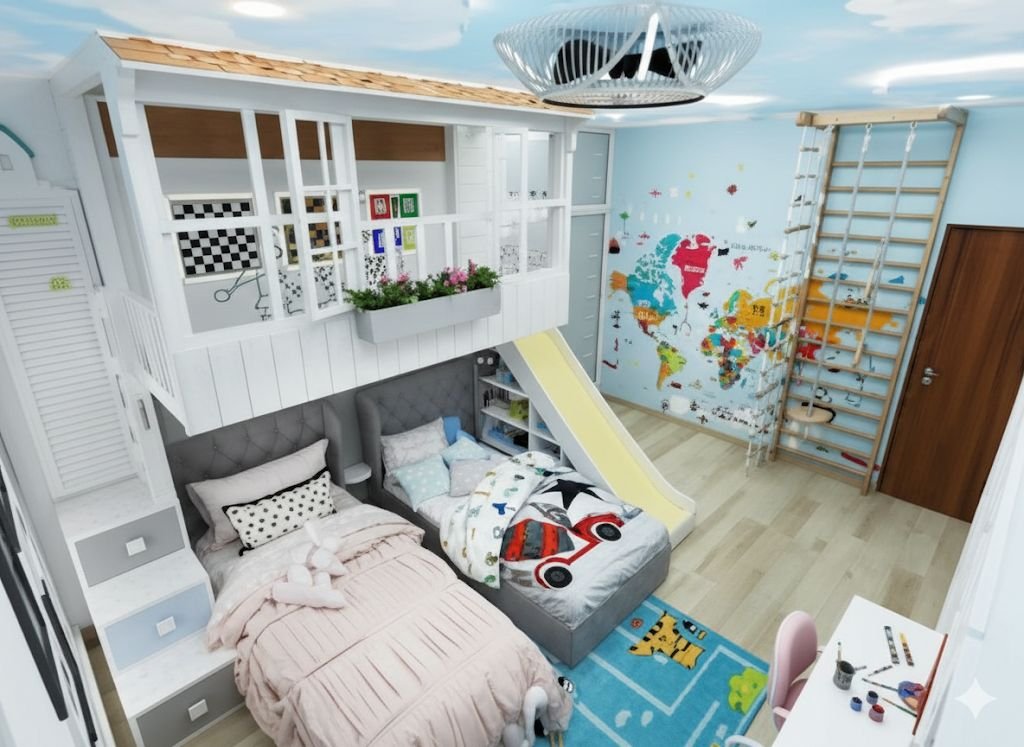



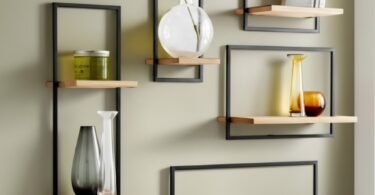
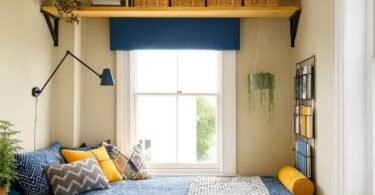
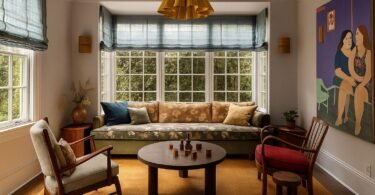
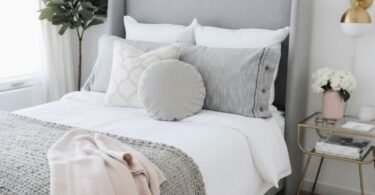
Leave a Comment